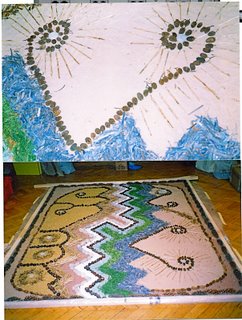Thursday, June 15, 2006
14 Materials and sources for School Coursework
The festival and its various resources have been successfully used by students for preparing high quality coursework.
Students working on GCSE coursework can use various aspects of the festival for independent research and study. Various thematic treatments can also be offered.
Some students may want to download materials from the website. Please see www.ephemeralarts.com Others may be interested in developing thematic links of their own but still connect with the website resources and this blog.
Students and teachers are welcome to contact the writer for further information and links. Please contact by email kalwant.ajimal@btinternet.com
Monday, June 5, 2006
13 Resources for Teachers and Librarians
The Festival of Ephemeral Arts has been presented by using a combination of the following resources:
- Practical workshops and supported learning experiences, working with senior artists, community arts practitioners and demonstrators with specific cultural backgrounds - one of our artists is a 78 year old Asian woman.
- Information: Use of the website at www.ephemeralarts.com
- A campaign: Use of a dedicated Touring Exhibition consisting of 18 boards
- Publication: A Teacher's Resource Pack
- Critical debate and information by using this web log.
- Dedicated provision for schools, libraries and museums. Three major projects are to be announced soon.
The Teacher's Resource Pack, the Touring Exhibition and selected photographs are now available for sale and loan. Please email Kalwant Ajimal for details using the email address provided in the column on the left of this page.
Sunday, June 4, 2006
12. Promoting Cross-Cultural Exchanges
 - inviting new readers
- inviting new readersThe creation of the Butterfly rangoli ( please see post 2) was based on the use of South Asian techniques and materials.
The 'rangoli' on the right was created by Sue Gande by using stones, twigs, coloured saw dust, sand, coloured woodchips and short grass cuttings to create her own abstract design. The top half of the picture shows the detail of the righthand side of the main work, where a 'v' shaped pattern is completed by two 'eyes'.
This is a large piece of work but shows common use of the floor as a base for the work, with careful use of a pattern which is then filled in with different materials than the Indian rangoli, on which this is based.
Other work created by our artists will show the use of grasses, sticks, stones, twigs and other materials found in a forest to create work that is similar to the work of the famous artist Andy Goldsworthy.
Further examples of floor based work can also be found in the website. Please see www.ephemeralarts.com Many communities use natural materials to create patterns on the floor. These designs are then used for a specific purpose and after the festival or celebration they are destroyed.
This is also a good time to add a few comments on how the other areas of ephemeral arts are equally exciting. The questions that I want to raise are:
- How will further additions to to this site benefit the range of people for whom it is intended?
- How can we help to develop networks and promote further information sharing?
- How can we promote the work of other artists who are not known to us?
- What specific input do teachers want from us to help them connect these ideas with the National Curriculum?
More about all these questions in the next few posts!


